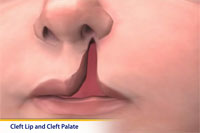
Cleft Lip and Cleft Palate
What is a cleft lip or palate?
The term "cleft" refers to an opening. An opening in the lip is called cleft lip. An opening in the roof of the mouth (palate) is called cleft palate. There may be a cleft on one side of the upper lip or on both sides. The split usually occurs only on the lip, but at times it may extend up into the nose as well. In the case of a cleft palate, many different types of openings are possible. The cleft may involve just the soft part of the palate at the back of the mouth or the cleft may extend forward to the bony part of the palate called the hard palate. The cleft could involve just the bony rim of the upper jaw, and the palate behind it may be OK. Sometimes a cleft of the palate involves a gap in the gum-line, the hard palate, and the soft palate. A baby may have a cleft lip, a cleft palate, or both.
One out of every 700 to 1000 babies has some form of cleft lip or cleft palate.
What is the cause?
The separate parts that form a baby's face and palate come together during early pregnancy. A cleft occurs if the parts do not fuse completely. Most of the time, no single cause for cleft lip or cleft palate is found. A cleft can occur without a known reason. Sometimes it can occur if the mother had a disease or abused drugs or alcohol while she was pregnant. Cleft lip and palate may be related to low levels of folic acid in the mother's diet.
Clefts can sometimes run in families. If either parent has a cleft, there is a greater chance that the baby will have a cleft. If you have a child with a cleft, the chance of your next child having a cleft is greater (even if both parents have no cleft). The chance of the next child having a cleft is still less than 4%.
Some children with clefts have other problems and birth defects as well. Sometimes clefts are associated with hereditary diseases that the family may be unaware of. Genetic tests can identify genes in some children that are responsible for clefting. It is important for your baby and you to see a specialist in genetics (a geneticist). The geneticist can help explain the cause of the cleft lip or palate and determine your chances of having another baby with a cleft.
How is it treated?
A team of healthcare professionals will also help take care of your child's hearing, speech, nutrition, teeth, and development.
- Surgery
Surgery to repair a cleft lip may be done at around 3 to 6 months of age. Surgery to repair a cleft palate is often done between 9 and 14 months of age.
- Feeding
The cleft can make sucking difficult and the milk may come back through the baby's nose. The baby may not be able to get enough milk from breast-feeding. However the baby can receive pumped breast milk through a special bottle, if needed. An occupational therapist can teach you how to feed your baby.
- Teeth
Your baby's teeth will be affected if the cleft is in the gum or the hard palate. Dental specialists will probably need to check your baby's tooth development as your child grows.
- Speech
Difficulties in speech may occur for many reasons. The quality of speech is often nasal and certain consonant sounds may be difficult for your child to make because air leaks through the nose. A speech and language therapist can help your child.
- Hearing
Babies with a cleft palate may have more ear infections. Difficulties in swallowing affect air pressure in the middle ear and spread infection through the nose to the ears. An audiologist and an ear, nose, and throat specialist will need to check your child's hearing often because frequent ear infections may lead to hearing loss.
Where can I get more information?
Talk to your child's healthcare provider to help find specialists and other resources. There are many treatment centers for cleft lip and cleft palate throughout the United States and Canada. They are referred to by many different names, such as cleft treatment centers, congenital defect clinics, or craniofacial clinics. You can get more information from:
Cleft Palate Foundation
http://www.cleftline.org
Children's Craniofacial Association
http://www.ccakids.com
American Speech-Language-Hearing Association
http://www.asha.org
Last modified: 2010-12-20
Last reviewed: 2010-12-20

